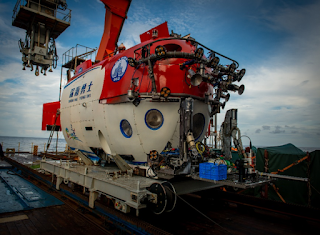 |
| Advanced Technology and Underwater Archaeology Unveil Historic Treasures in the South China Sea Image credit: China Science |
China's National Cultural Heritage Administration has recently announced significant archaeological findings from the Northwest Continental Slope No. 1 and No. 2 Shipwreck sites in the South China Sea. These discoveries are the result of advanced underwater archaeology and cutting-edge technology working together to explore long-lost treasures more than a kilometer below the sea surface.
Technological Advancements in Deep-Sea Archaeology
In the past, China's underwater archaeology was limited to coastal and shallow waters due to less developed deep-diving technology. This changed in August 2017 when China's second manned deep-sea submersible, Deepsea Warrior, completed its first manned dive. This marked the beginning of China's deep-sea archaeology efforts, allowing exploration in the blue depths and uncovering the underwater imprints of Chinese civilization.
 |
| Ship for archaeological findings at the Northwest Continental Slope No. 1 and No. 2 Shipwreck sites in the South China Sea Image credit: China Science |
Role of Deepsea Warrior in Recent Discoveries
The Deepsea Warrior played a crucial role in the recent archaeological survey of the shipwreck sites. Equipped with a long baseline positioning system for precise navigation, 3D laser scanners, high-definition cameras, and flexible robotic arms, the submersible effectively captured detailed images and extracted artifacts without causing damage. This technology has allowed archaeologists to retrieve artifacts that tell the story of history and showcase technological progress.
Historical Significance of the Artifacts
Artifacts recovered from the shipwreck sites, such as pottery and porcelain pieces with inscriptions like "Fu (fortune)," "Zheng (righteousness)," and "Taiping (peace)," provide insights into the daily lives and social landscape of people from centuries ago. These artifacts reveal tales of joy, hardship, exploration, and perseverance, and serve as evidence of the prosperous maritime trade during the mid-Ming Dynasty. They highlight the significant cultural and trade exchanges along the ancient Maritime Silk Road.
Integration of Technology in Cultural Heritage
Modern technology is not only aiding in the discovery of historical artifacts but also enhancing the public's interaction with cultural relics. Virtual reality, augmented reality, holographic projection, and artificial intelligence are increasingly applied in cultural heritage fields. For instance, the new Sanxingdui Museum in Sichuan province uses naked-eye 3D technology to recreate archaeological sites, and the Grand Bao'en Temple Museum in Jiangsu province has developed a metaverse program for exploring Ming Dynasty-era sites.
 |
| Sui Tang Grand Canal Culture Museum in Luoyang City, Henan Province. Image credit: China Science |
Future Prospects and Technological Impact
Technology is expanding the boundaries of human cognition, enabling deeper understanding of ancient populations through carbon-14 dating, ancient DNA studies, and organic residue analysis. This integration of technology allows archaeologists to revive and interpret the stories of civilizations buried or submerged for thousands of years, making cultural relics more dynamic and accessible to the public.
By harnessing advanced technology, archaeologists are not only decoding the past but also paving the way for future discoveries. This synergy between technology and archaeology helps trace the origins of Chinese civilization and expand the historical memory of human civilization, ensuring the sustained vitality of cultural relics as they enter people's lives in more engaging ways.










0 Comments